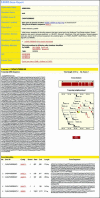CADRE: the Central Aspergillus Data REpository
- PMID: 14681443
- PMCID: PMC308744
- DOI: 10.1093/nar/gkh009
CADRE: the Central Aspergillus Data REpository
Abstract
CADRE is a public resource for housing and analysing genomic data extracted from species of Aspergillus. It arose to enable maintenance of the complete annotated genomic sequence of Aspergillus fumigatus and to provide tools for searching, analysing and visualizing features of fungal genomes. By implementing CADRE using Ensembl, a framework is in place for storing and comparing several genomes: the resource will thus expand by including other Aspergillus genomes (such as Aspergillus nidulans) as they become available. CADRE is accessible at http://www.cadre. man.ac.uk.
Figures


References
-
- Pitt J.I., Samson,R.A. and Frisvad,J.C. (2000) List of accepted species and their synonyms in the family Trichocomaceae. In Samson,R.A. and Pitt,J.I. (eds), Integration of Modern Taxonomic Methods for Penicillium and Aspergillus Classification. Harwood, Amsterdam, pp. 9–49.
-
- Marr K.A., Patterson,T. and Denning,D. (2002) Aspergillosis. Pathogenesis, clinical manifestations, and therapy. Infect. Dis. Clin. North Am., 16, 875–894. - PubMed
-
- Pontecorvo G., Roper,J.A., Hemmons,L.M., MacDonald,K.D. and Bufton,A.W.J. (1953) The genetics of Aspergillus nidulans. Adv. Genet., 5, 141–239. - PubMed
-
- Martinelli S.D. and Kinghorn,J.R. (eds) (1994) Aspergillus: 50 Years On. Elsevier, Amsterdam.
-
- Bennett J.W. and Klich,M.A. (1999) Aspergillus. In Flickinger,M.C. and Drew,S.W. (eds), Encyclopedia of Bioprocess Technology: Fermentation, Biocatalysis, and Bioseparation. John Wiley and Sons, Inc., New York, pp. 213–220.

